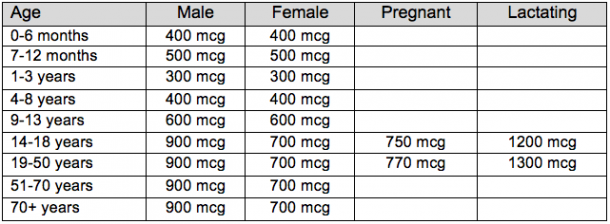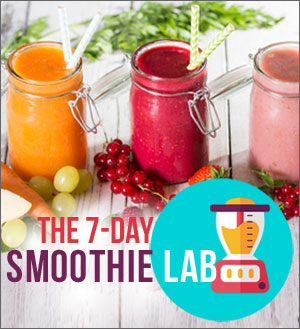 The term vitamin A refers to several different molecules, which are chemically related.
The term vitamin A refers to several different molecules, which are chemically related.
Forms from animal sources are called preformed vitamin A. Carotenoids from plant foods are called provitamin A. Alpha- and beta-carotene are two examples of provitamin A.
Carotenoids must be converted to active forms in the body, and on average have about half the biological activity of an equal amount of preformed vitamin A.
Vitamin A plays a critical role in the chain of chemical reactions that control vision. Night vision and adaptation to low light, is particularly dependent on vitamin A. Other important roles for vitamin A are regulation of gene expression, cell growth, immune function, and red blood cell production. Vitamin A is also important during pregnancy, for cell growth in the fetus.
Because different forms of vitamin A have varying levels of biological activity, vitamin A recommendations are now given in activity units instead of by weight. These units are called Retinol Activity Equivalents, or RAE. For example, 1 microgram of carotene might only equal half as many RAEs as 1 microgram of preformed vitamin A from chicken livers.
Recommended Dietary Allowances for Vitamin A (RAE)
 Source: Office of Dietary Supplements, National Institutes of Health
Source: Office of Dietary Supplements, National Institutes of Health
Which Foods Have Vitamin A?
Plant foods contain provitamin A carotenes, while animal foods contain preformed vitamin A.
Beef liver
Carrots
Carrot juice
Pumpkin, cooked
Sweet potato
Spinach
Collard greens
Kale
Turnip greens
Chicken liver
Beet greens
Turnip greens
Winter squash, such as butternut
Mustard greens
Apricots
Papayas
Broccoli
Herring, pickled
Cantaloupe
Dark green lettuce
Sweet red peppers
Tomato sauce
Peas
Mangos
Salmon
Tangerines
Eggs
Tomatoes, raw
Asparagus
Brussel sprouts
Ready-to-eat cereals are usually fortified with varying amounts of vitamin A.
What Happens If You Don’t Get Enough Vitamin A?
Vitamin A deficiency is a leading cause of blindness in developing countries, where high vitamin A foods are less available. In the US and developed countries, this severe problem is rarely seen, but mild deficiency can cause damage to the eye.
Vitamin A deficiency can aggravate other nutrition deficiencies, such as iron. And some nutritional deficiencies can have a negative impact on vitamin A status. For example, zinc deficiency decreases production of the protein that carries vitamin A in the blood.
Because vitamin A is important to immune function, deficiency is associated with higher rates of lung disease and diarrhea, especially in children in developing countries. Vitamin A deficiency during pregnancy can cause birth defects, due to the vitamin’s important role in regulating cell growth and differentiation.
But excess vitamin A can also cause birth defects, so pregnant women should avoid high intake of preformed vitamin from food and supplements.
Vitamin A is fat soluble, so excess amounts are stored in the liver. Toxicity is more often caused by excess intake from supplements. In one well known case, although polar bear liver eaten by Arctic explorers was responsible for vitamin A toxicity.
Other symptoms of toxicity include headache, dizziness, skin irritation and increase risk for bone fractures due to bone demineralization. The provitamin A carotenoids in plants are not known to be toxic, although high intake of these foods can give skin an orange tint.


 Are you ready to look better, feel more energized, and get back that youthful feeling you remember having as a kid? I can help you on a journey that will change the way you eat — for good. My
Are you ready to look better, feel more energized, and get back that youthful feeling you remember having as a kid? I can help you on a journey that will change the way you eat — for good. My 














 As a healthy cooking expert, health coach and TV host,
As a healthy cooking expert, health coach and TV host, 



Speak Your Mind